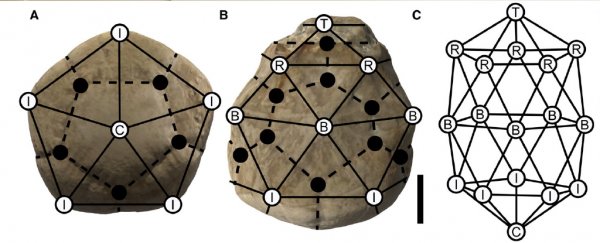Life on the ocean floor 80 million years ago was tough. Sea levels were shallow, predators were ever on the prowl, and there was always some other slimy, spiky, hard-shelled critter willing to steal your spot.
To survive, ancient relatives of the sea urchin reshaped their anatomy to become dead ringers for robust organic molecules made of carbon, known as buckyballs. It wasn't merely a solid choice, either – it was their mathematical destiny.
Fossils representing two primitive echinoderm species from the Late Cretaceous period reveal that the arrangements of their protective plates, called a calyx, were geometrically similar to the polygons of carbon spheres.
Comparing the underlying rules responsible for the structures allows us to understand how the animals' body shapes were able to diversify in response to environmental pressures, researchers explain in a new study.
To find clues on the kinds of constraints the ancient animals faced in their ability to adapt, a team from the University of Western Australia (UWA) and the University of Cambridge used special graphing techniques, to quantify the structural layouts of Uintacrinus socialis and Marsupites testudinarius, which belonged to a class of echinoderms known as crinoids.
Some layouts would have created less stable forms, while others just wouldn't have been possible. Networking the calyx's topology, or geometrical arrangements, helps researchers better understand the way forward – or even back – in natural selection.
"Survival was critical and the ball-like structures, able to withstand very heavy loads, formed around them to protect them from the harms of the ocean and aid buoyancy," says UWA evolutionary palaeoecologist Aaron Hunter.
At first glance, many crinoids might easily be mistaken for plants, with frond-like appendages waving in the ocean currents, and a stalk anchoring their calyx to the sea floor.
These two Cretaceous examples happened to buck that trend, ditching the stem altogether to settle into the soft powder of the limestone floor, or to rise up through the currents to seek out less treacherous pastures.
 Uintacrinus sp. with its structure networked. (Cuthill & Hunter, Palaeontology, 2020)
Uintacrinus sp. with its structure networked. (Cuthill & Hunter, Palaeontology, 2020)
"These animals could then spread around the world and have been found in chalk rocks from Texas, US to Kalbarri in Western Australia," says Hunter.
"They could form a snowshoe to sit on the bottom of the shallow oceans or float and relocate to safer places."
Their near-spherical calyces also looked more or less alike. Marsupites had 16 large, five- or six-sided plates in a soccer-ball type arrangement, compared with Uintacrinus' numerous tiny ones, comprising four-to-eight sides each.
These arrangements, the scientists found, weren't just reminiscent of carbon nanostructures. They were mathematically a match, with Marsupites looking just like a blown-up version of a spherical molecule made of 30 carbon atoms.
The most famous example of carbon spheres like this is the buckminsterfullerene, after the 20th century American inventor and architect, Buckminster Fuller.
His geodesic dome design – realised in famous structures such as the massive Eden Project in Cornwall, UK – married the strength of such polygon arrangements with a modernist aesthetic.
It seems Fuller was beaten to the punch by around 80 million years, though.
"The structures are also found in the carbon molecule buckminsterfullerene, but this is the first time we have found such a structure in fossils," says Hunter.
"It still remains a mystery why these successful structures did not evolve again."
That question of why it's a rare shape in nature, given its potential for standing up against a predator's bite, depends largely on just how easily it can arise in the first place.
The timelines of Uintacrinus and Marsupites overlapped for roughly a million years, back when dinosaurs still roamed.
The period also happened to also be at the tail end of an era that saw new kinds of shell-crushing predators evolve, putting pressure on hard-shelled creatures in the ocean depths.
By analysing the topological arrangements of these plates as a network, the researchers could compare these structures with all of the possible shapes available, helping better understand how their evolution could have occurred.
It turns out that for the crinoid Marsupites, a stable buckyball structure was in the cards, with graphing models showing limited pathways to other possible body plans.
Uintacrinus wasn't quite so fortunate. Its own layout was a good attempt, but those smaller, uneven plates wouldn't have provided the same rigidity.
This kind of network mapping of body shapes has been applied in other areas of biology, but it's still a tool with plenty of unrealised potential for understanding why some evolutionary branches boom, while others go bust.
Evolution can often feel like a wild gamble. But in many cases, the cards are heavily stacked.
For these ancient urchins of the sea, it was a lucky hand that saw them hold out for a while in a world bent on seeing them lose.
This research was published in Palaeontology.
